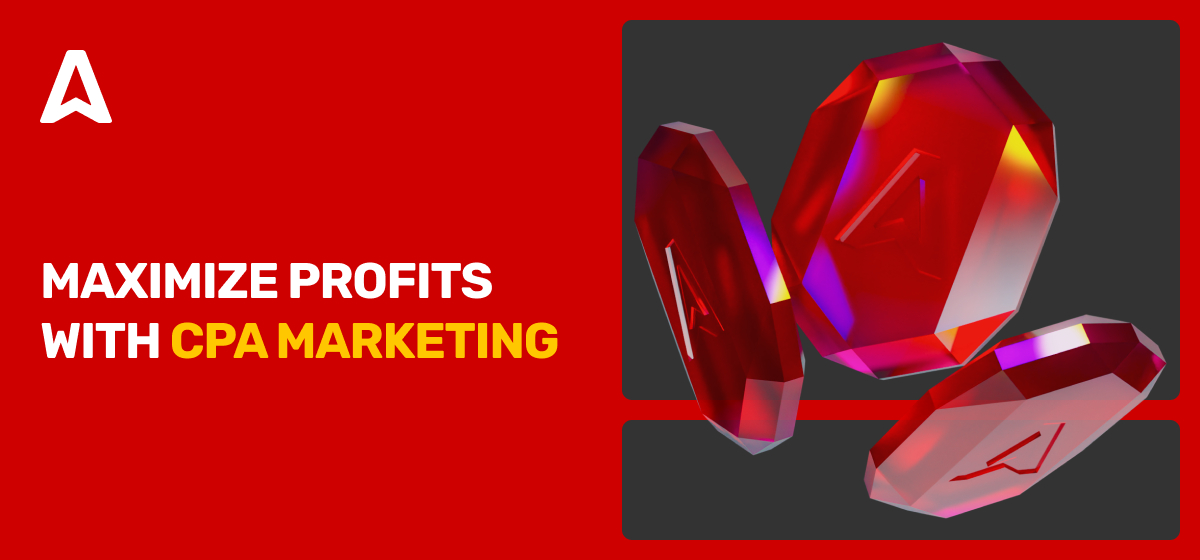Affiliate marketing can be lucrative if done right. A little expense on the right traffic sources can generate a high return on investment. Knowing the best affiliate traffic sources in digital marketing is vital so that you don’t waste money. This article will show you exactly that.
Summary
- Dual roadmap explaining 10 paid traffic sources (e.g., Push, Popunder, Native) alongside 10 organic channels like TikTok, SEO, Quora, and more.
- Smart criteria for choosing the right source—cost vs. volume, targeting, traffic quality, restrictions, and ad policies.
- Advanced traffic-generation strategies: AI-powered SEO, webinar funnels, Reddit/Quora, and email to scale smarter.
- Trends affecting affiliates: mobile-first marketing, campaign personalization, the shift in payment models, and more.
- FAQs clearing confusion on best source types, free vs. paid traffic, and traffic ROI optimization.
What is an affiliate traffic source?
A traffic source refers to any platform that can send visitors to an affiliate site, landing page, or CPA offer. It is the medium through which people find a website or offer you promote. Monitoring these sources can help you understand what attracts users and focus on doing more of that to keep the traffic coming.
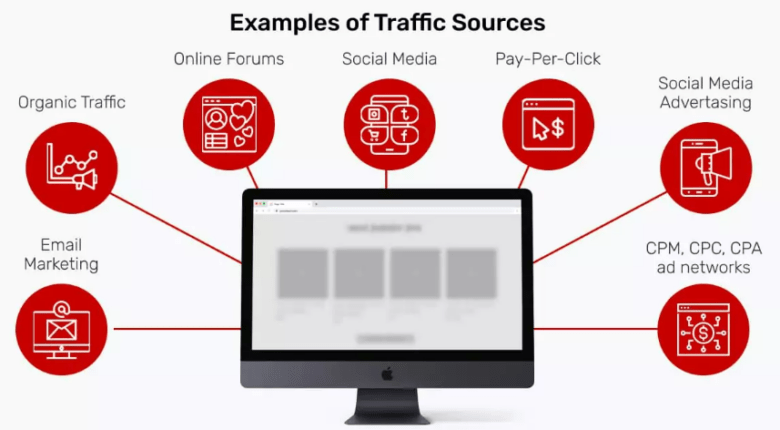
Traffic sources for affiliate marketing can be either paid or organic (free) traffic. Traffic comes from free traffic sites, like social nets, Quora, Reddit, etc. and other unpaid sources. Organic traffic is achieved via search engine optimization with the help of handy, easy-to-use tools that we talk about in detail in our Guide on Best Strategies for Integrating AI and SEO in Your Marketing Plan. The most popular types of organic traffic are search engines like Google, Bing, and DuckDuckGo.
Best paid traffic sources for affiliate marketing, on the other hand, come to your affiliate website after you pay for advertising promotions on social traffic, search engines, and blogs.
Paid traffic
Paid traffic covers a wide range of paid advertising sources you can leverage to drive traffic to your website or a CPA offer. These include paid ads with popular search engines like Google ads or Bing ads, monetizing with affiliate marketing on Facebook or Instagram, and other social media platforms, and also online advertising networks that allow you to demonstrate ads to high-converting audiences.
Paid ads are usually competitive, so your budget can sometimes be substantial. However, they offer a high return on investment for affiliate marketers.
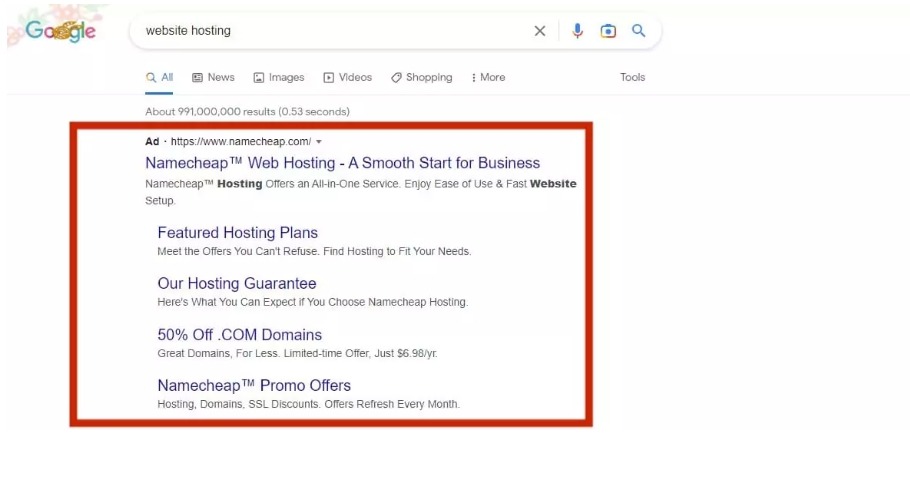
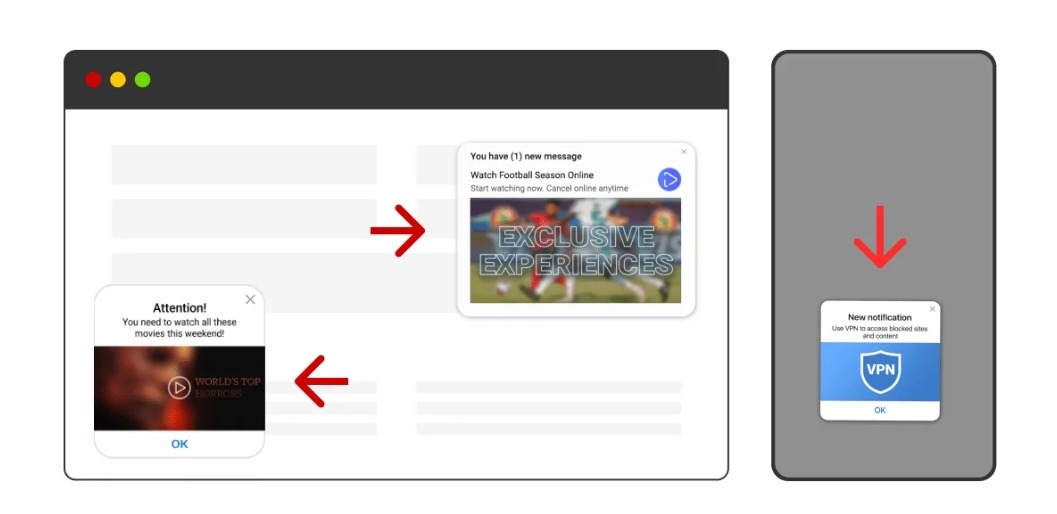
Adsterra works with over 36,000 direct publishers from 248 GEOs that can generate high-quality traffic for CPA offers you promote. You can rely on Adsterra to use the top converting ad formats with 30% higher CTRs than web push ads for your ad campaigns.
Organic search traffic
You don’t need to pay a dime for organic traffic that comes from search engine results, say from Google search. However, it takes time to build, unlike paid traffic. Search engine optimization (SEO) is the most common way to get organic traffic. You should structure your website and posts in a way that makes them rank high on search engines. Apply keyword research, use the right keywords (but please mind keyword stuffing that Google doesn’t like), headings, image formats, etc. Backlinks from other websites also help build up organic traffic and attract visitors.
The good thing about this type of traffic is that once you build it up, it has a lot of staying power.
How to choose the right traffic marketing source?
There are many factors to consider for affiliate marketers to bring business success when picking a good source of affiliate marketing traffic:
- Cost, or how much you’ll pay for the traffic;
- Amount of traffic;
- Advertising regulations across networks;
- Quality of the affiliate marketing traffic sources;
- Ad targeting options;
- Target audience and niche (sub-niche) with potential customers.
Traffic source costs
Every paid traffic source has a specific cost from the traffic suppliers, depending on its type, quality, the number of locations you target, etc. There’s much competition for websites that bring high-quality affiliate traffic, so they tend to cost more than those of lower quality.
You should have a defined budget and plan an advertising strategy that fits within it.
2. Traffic amount available
So, how to generate traffic for affiliate marketing? First of all, the amount of traffic you can generate from different sources isn’t the same. Some sources may give you traffic from only Tier 3 geographical locations with large volumes and lower costs. Others will let you target Tier 1 GEOs with higher costs. You should decide on the tier of traffic you’re interested in and identify where to get it for a certain cost you determine to pay.
3. Restrictions, regulations, and rules
Different affiliate advertising networks have different rules for advertisers. Most of the laws concern misleading advertising and product categories. Check the regulations of the affiliate traffic sources you want to advertise on and know what they prohibit. Violations can get you banned from a traffic source for life.
4. Overall quality of traffic sources
There are two main things that affect the quality of a traffic source:
- Bot traffic is a major problem in many ad traffic networks, making advertisers see large traffic volumes but little or no conversions.
- Some networks cater to low-quality audiences, i.e., generate little sales for your product.
Ensure that the traffic source you’re patronizing has a clean reputation or has been explored by someone you know with good results. This will prevent you from falling victim to click fraud and getting little return on your ad spend, instead of positive ROI.
5. Targeting options for advertising campaign
Targeting lets you tailor your affiliate marketing campaign to more visitors that are most likely to respond to them. Examples of targeting setting options:
- Location,
- Type of device (desktop traffic or mobile traffic),
- Web browser,
- Language,
- Operating system,
- Time of the day, etc.
Different traffic sources allow for different targeting options. For example, some don’t allow advertisers to target by location, browser, or more precise targeting. When you plan your affiliate marketing strategy, list out your most preferred targeting options and ensure you pick sources that support exactly those settings you need. In Adsterra advertiser’s dashboard, you can tweak your ad marketing campaigns granular with over 20+ settings.
6. Niche or audience
This factor is closely related to targeting options, as different businesses serve different niches and audiences. Some traffic sources are best suited for specific niche websites. For example, if you’re selling a nutritional product, you should pick social networks as your source of paid traffic. You could create a detailed review of the product in your blog and drive organic, or paid search traffic there.
Likewise, some affiliate sites have more traffic from specific locations than others, so it’ll be smart to bank on traffic sources with a multi-location option. Check everything about your intended traffic source before jumping in to give them money.
If you’re an affiliate looking for top traffic sources, Adsterra is your surefire choice. It drives traffic from 248 GEOs and has the unique Partner Care Program. If you’re in search of massive traffic for your affiliate offers, try the Adsterra ad network. We send 35 billion+ ad impressions from selected publishers’ websites monthly.
10 Top paid traffic sources for affiliate marketing
Any marketer needs both paid and organic traffic. But the former is the best for driving significant traffic to your product website and getting sales. You can always pay for traffic using the pricing models that are best suited for you: cost-per-click, cost-per-mille, cost-per-action, pay-per-click, etc.
1. Push traffic
Push advertising means delivering ads in the form of push notifications. Push ads are the perfect blend of non-intrusiveness, user-friendliness, and visual appeal, enabling you to easily grab the viewer’s attention.
Push ads can take the traditional Web Push format delivered via web browsers or In-Page Push delivered directly on web pages. In-Page Push is the more advanced version that lets you use customized push notification layouts to attract users. You can run Social Bar ads on Adsterra that combine the advantages of display ads and In-Page Push — our ads work with all browsers and don’t require subscriptions like web push.
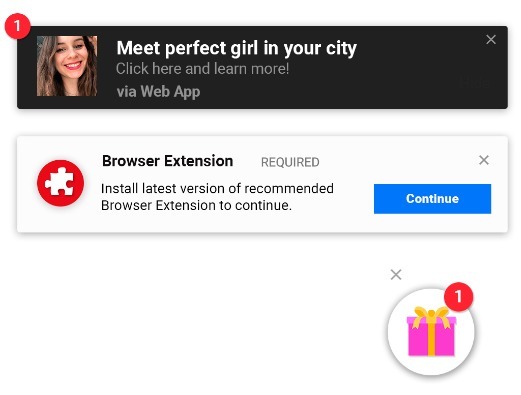
Check our affiliate case study on In-Page Push traffic:
2. Pop traffic
There are two types of pop traffic: Popups and Popunders. Popup is when a new advertising window appears on top of a webpage. Popunder is an ad that loads under the webpage, and you can only see it after closing the webpage. Popunder ads are more effective than Popups because the latter causes interruptions while the former doesn’t.
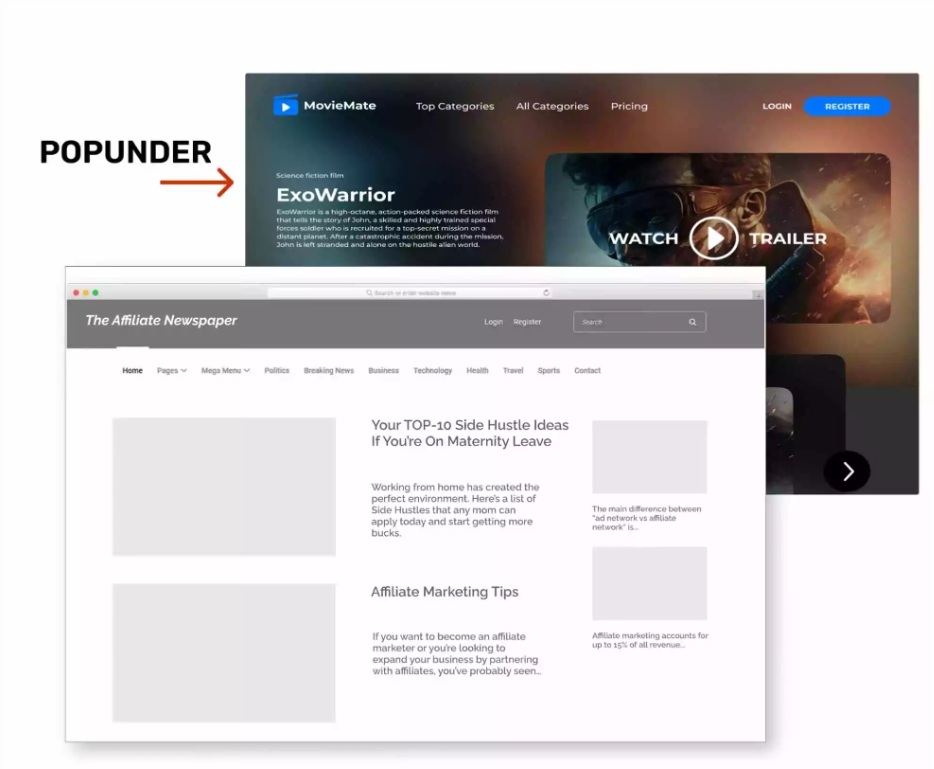
3. Banner ads
This type of ad is a simple clickable banner on a website or between posts on a social media platform. It’s an image with a hyperlink that leads anyone who clicks on it to an external URL. It is the most common type of ad that you can use anywhere, including on websites, social media, and even email. The key is to design an eye-catching ad using the right mix of images and text. Any text should also be short and go straight to the point.
A slight problem with banner ads is that people see them too much and have become numb to them (ad fatigue). The best positions for banner ads are usually at the top or left side of a web page, where people are likelier to see them.
4. Native advertising
Native advertisements match the look and feel of your website. They resonate with your traffic source’s audience and don’t have the perceived intrusiveness of many other types of ads.
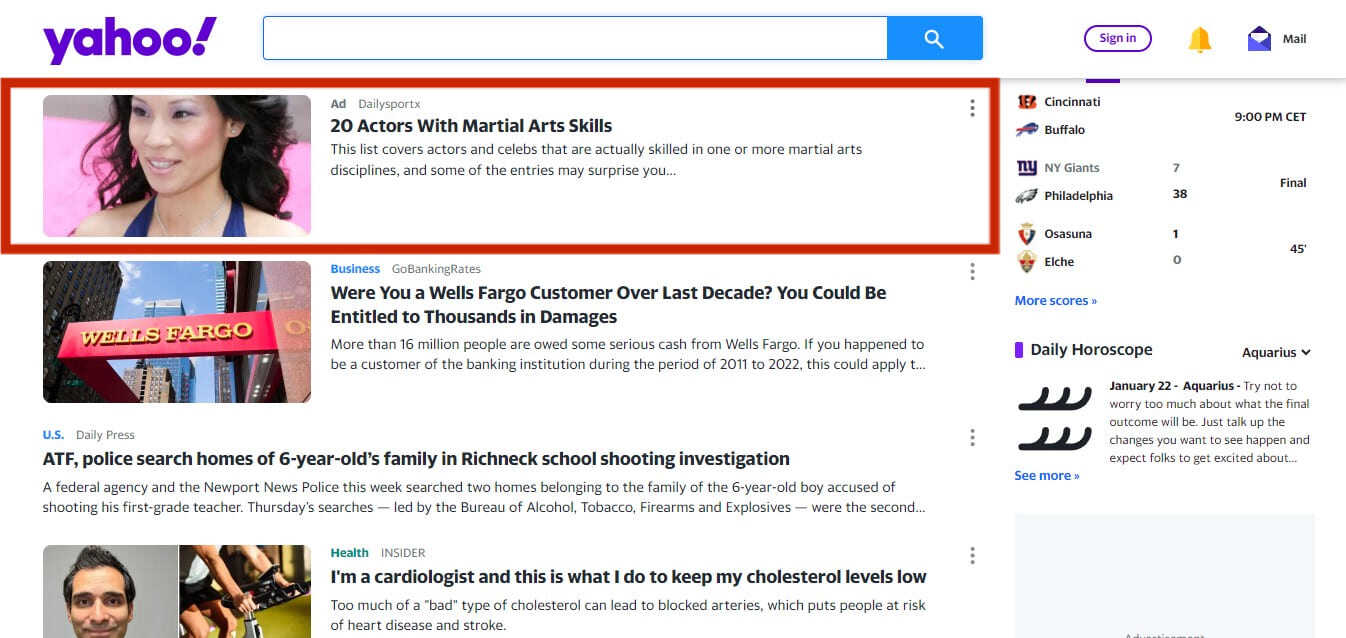
5. Video marketing
You can use videos to advertise third-party affiliate products. Videos are more likely to capture a reader’s attention than images and text, so use the opportunity to impress the reader and clearly state what your product is. Note that video ads tend to cost much more than other types of ads, so it’s not suitable for beginner affiliates.
6. Paid search ads
You can put ads for your affiliate site, like Google ads and Bing ads, though there are good alternatives to Google Ads. Here, you pay only when someone clicks on your ad. You can bid for specific keywords, and your link will show when a person searches for them. However, bidding for commonly searched terms like “insurance” or “medical services” is fiercely competitive and drives up the price for intending advertisers.
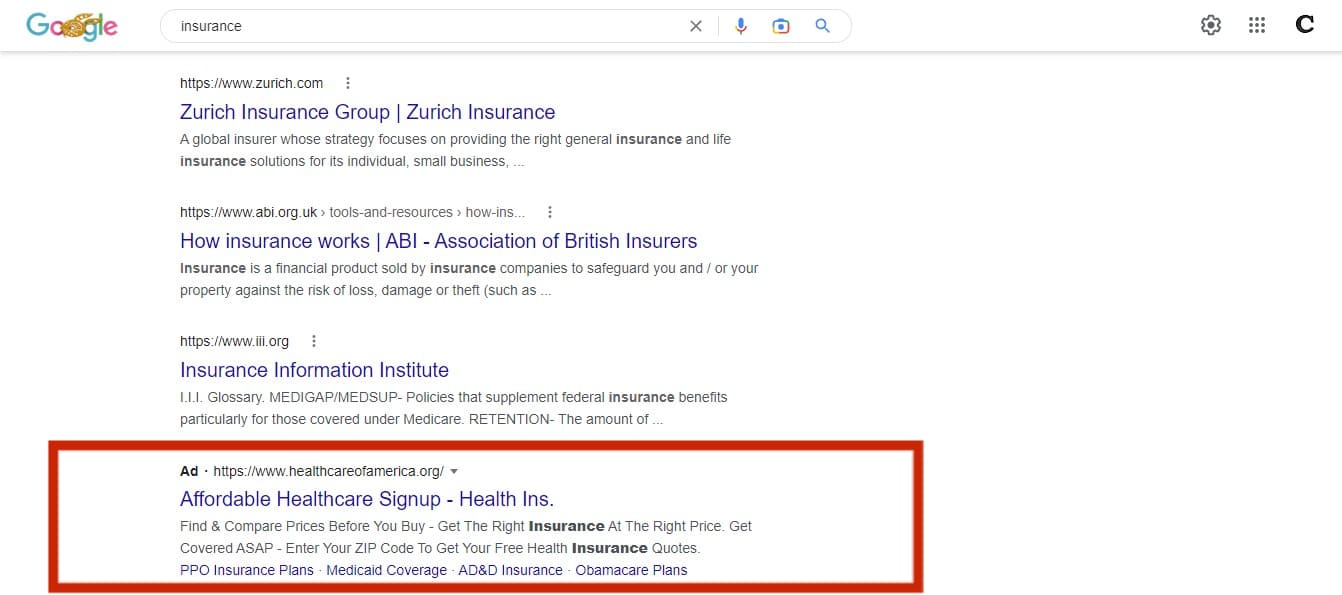
7. Social media ads
You can advertise on popular social networks like Instagram, Reddit, X (formerly Twitter), LinkedIn, and Facebook pages. When someone clicks your display ad within social media campaigns, they’ll be redirected to your social media page or an external landing page. Billions of people use social media, so it’s a good platform to reach potential customers.
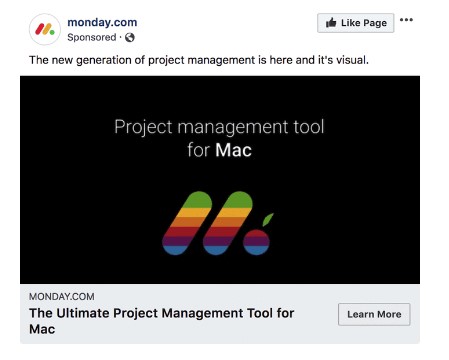
The best way to use social media for affiliate marketing is to write a product review and include direct affiliate links. Mind that most social media platforms don’t allow people to promote multiple affiliate links, even with disclosure.
8. URL shortening tools
A URL shortener is a tool that converts a long URL into a shorter one that’ll still take anyone who clicks on it to the same webpage. Some of them offer affiliate services so that whenever someone clicks on a shortened link, they’ll see an ad before going to the intended website. This ad space is a good medium to generate traffic for your own product or landing page.
Publishers connected to Adsterra generate over 1 billion impressions daily, presenting an amazing opportunity to spread the word about your product.
9. Email marketing
Email is one of the best approaches to generating affiliate marketing traffic sources, but it’s often overlooked. You can advertise in email newsletters that match your desired target audience and get good results. For example, if you’re promoting a finance app, you can advertise on newsletters dedicated to stock market investing, which will likely drive additional traffic and visitors to your offers from affiliate program or companies.
You can also build your own email newsletters and share affiliate links in them. However, this method takes much longer than paying to advertise in existing newsletters.
10. PPV traffic
PPV means pay-per-view. In this case, you place ads on an advertising network and pay for each time someone views your ad. It means a user must watch a piece of content (usually, a popup or a video).
PPV traffic is an effective method of generating traffic and visitors for your affiliate campaign, especially if you’re advertising digital products. You can bid for specific sites and keywords to get the best results.
10 Best free traffic sources for affiliate marketing
Now, it’s time to show you the best free traffic sources for affiliate marketing, the ones you don’t need to spend money on. They are mostly social media sites, online forums, and search engines. However, it’s harder to build up incoming traffic on these sources than on paid ones, so you must work creatively with them.
1. TikTok
TikTok is the world’s most popular short-form video app, with over 1.7 billion users worldwide. It is renowned for its algorithm, which feeds users tailored videos they enjoy watching.
You can create TikTok videos to promote your affiliate offers to the perfect target audience. This app doesn’t let you post links directly on non-sponsored posts, but you can post the link in your profile section and direct users to click on it. TikTok is one of the best traffic sources for affiliate marketing because it lets you connect with your ideal potential customer profile.
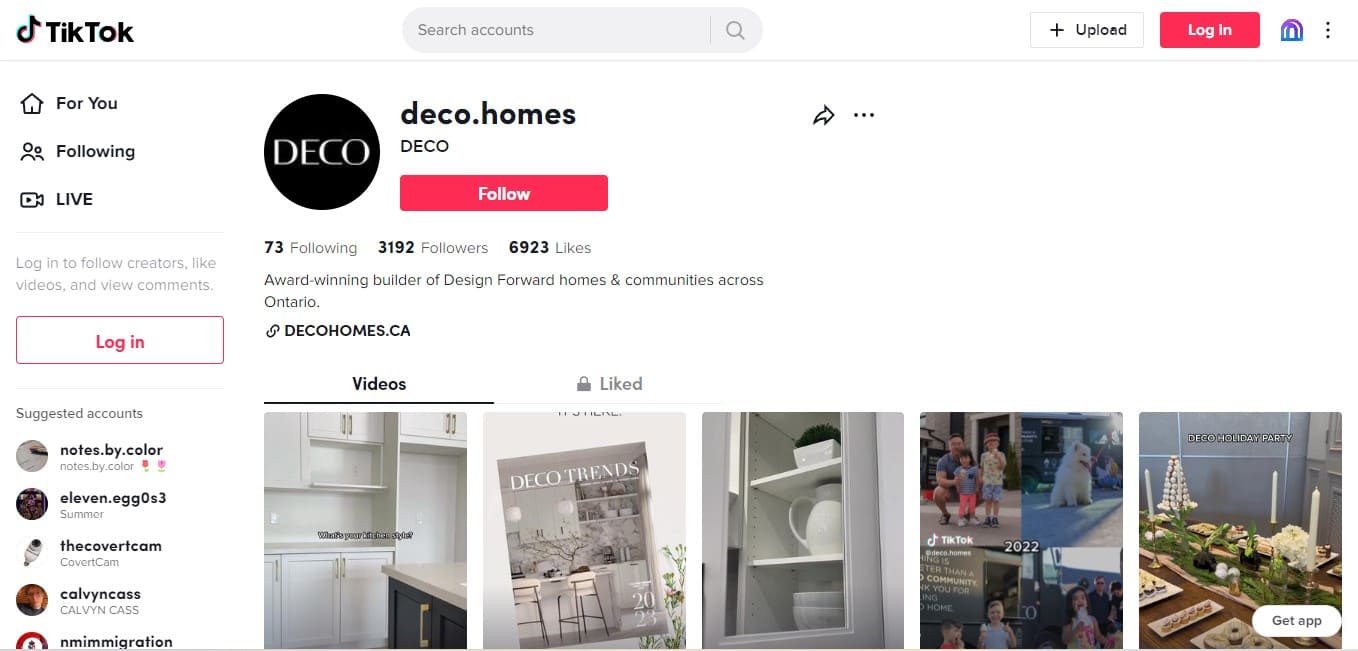
2. SEO traffic
If you’re using your affiliate website, product page, or blog for affiliate marketing, you can’t do without search engine optimization (SEO). Search engines are the biggest drivers of traffic on the web, so it’s essential to do landing page optimization to make them rank high, preferably on the first page. Alternatively, you can go without a website and do a great job of it by checking our guide.
Each search engine has unique ranking algorithms. But some general rules to improve your website’s rank include using keywords, having backlinks, and adding relevant names and alt texts to images. SEO is a moving target. With rapidly evolving AI searches, you should ensure to stay on top of industry changes and adapt to them whatever vertical you are in.
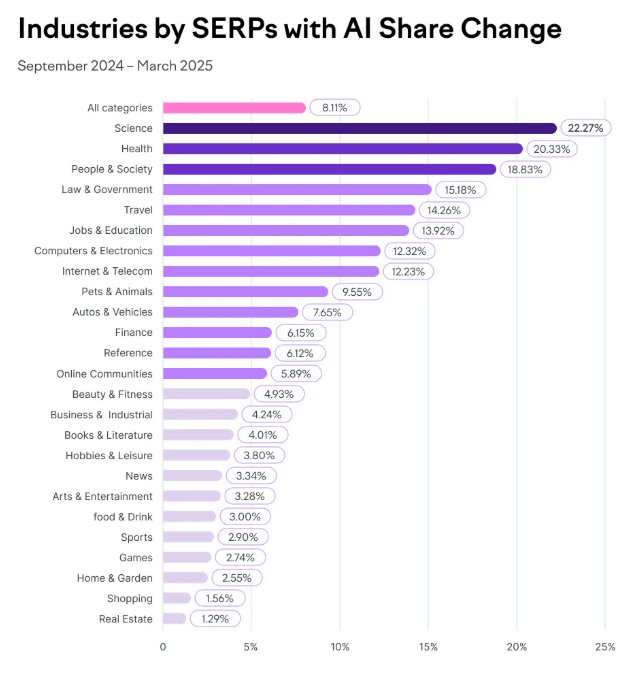
3. X (formerly Twitter)
X (formerly Twitter) is one of the most popular social media platforms globally. It’s the first place people go to find out about global events or things happening close by. X users are all about conversations and don’t like being sold to, so just putting your links won’t suffice. You’ll need to add visuals related to the content behind the link.
Sometimes, one of your tweets can blow up, and you can insert your links at the end of the viral thread. You can also add them to your bio, as you’ll do on TikTok.
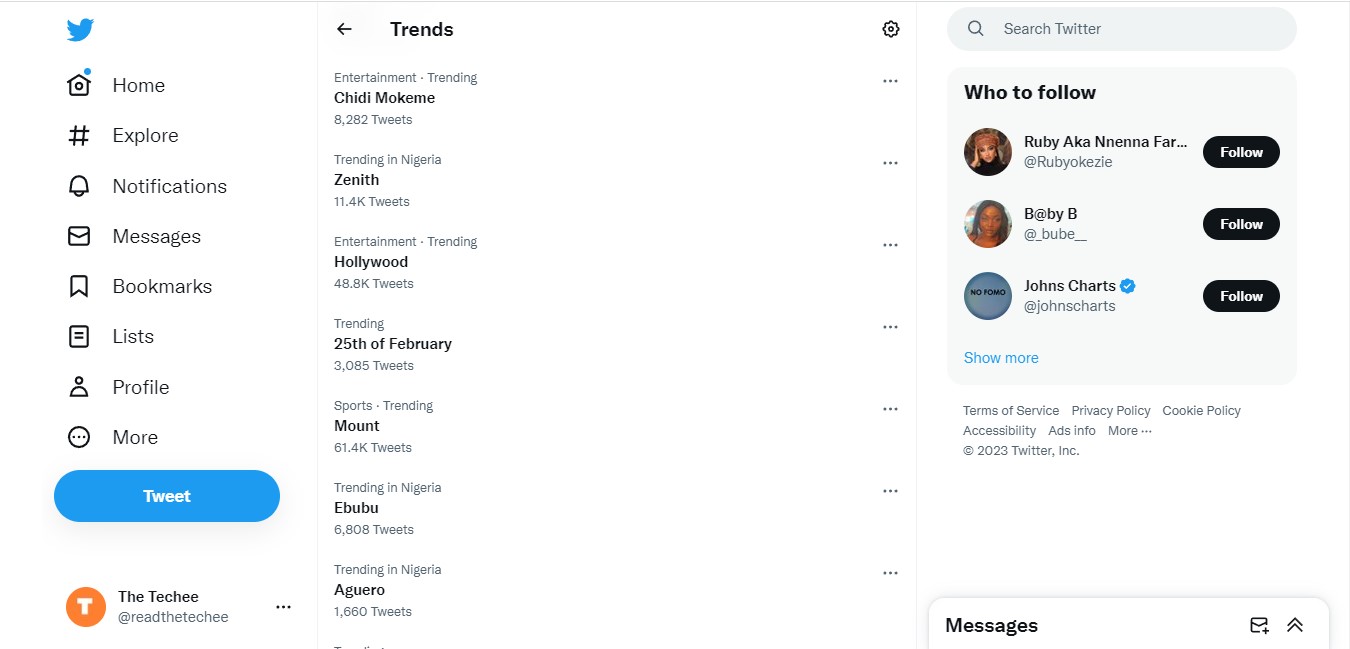
4. Instagram
Instagram is a popular social media platform where users share images and videos. To be a successful affiliate marketer on Instagram, you must first build a following rather than just throw links into your content. You can use hashtags and geotags to improve local discovery, get featured on already popular accounts, etc. Afterward, you can post different types of visual content or create content like how-to guides with your affiliate links and also on your bio.
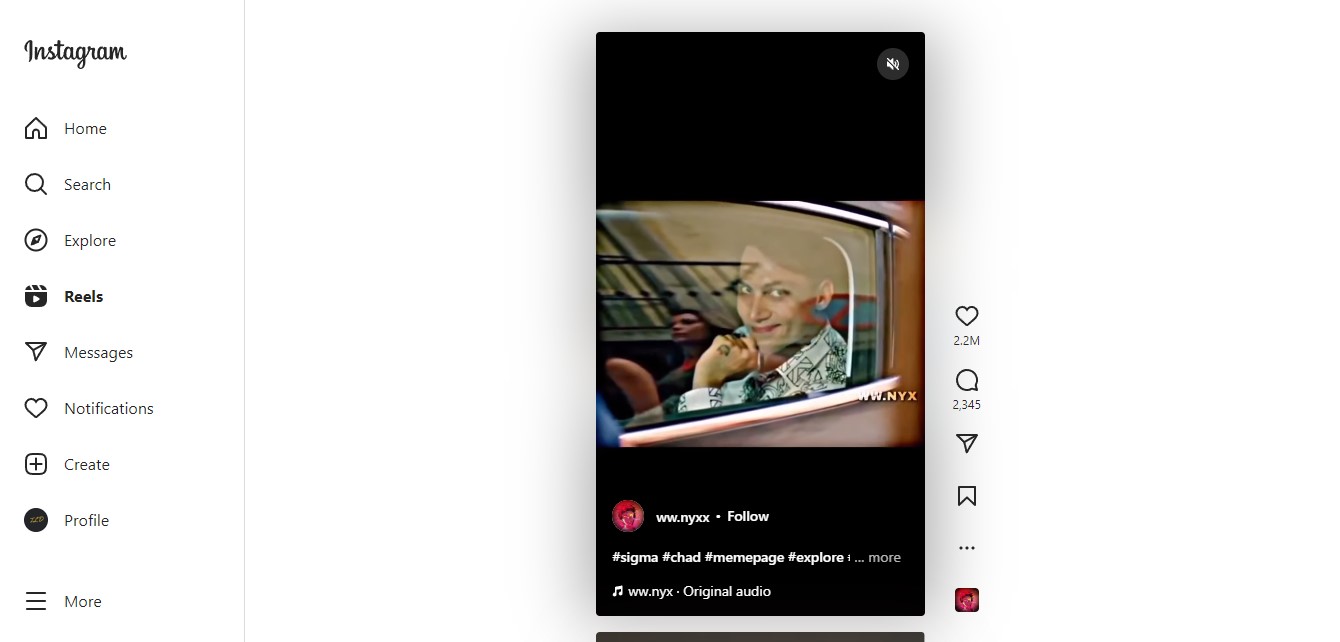
Ready to crush it with affiliate marketing on Instagram? Follow Adsterra for quick tips, fresh ideas, and the latest trends to boost your success.
5. Pinterest
Pinterest is a social network that revolves around sharing ideas through “pins.” This platform skews toward a female audience, but the gap is getting smaller as more men flock toward it. Many people use Pinterest to look for purchase ideas, so you can post your products as “pins” along with their affiliate links. Anyone who searches for product ideas may see your post and follow the affiliate link to purchase it.
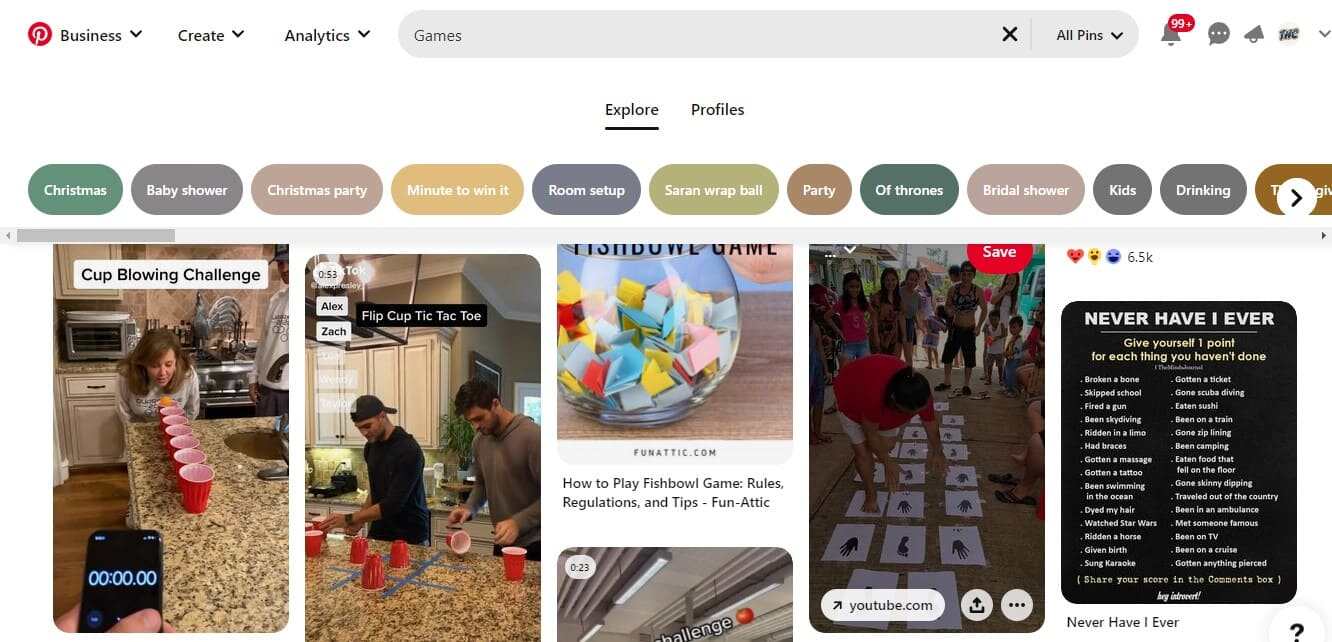
6. Online forums
If you’re into a particular activity, odds are there’s a forum dedicated to it. Like-minded people tend to congregate on forums to discuss relevant topics, presenting an opportunity for you to market your product. For example, if you promote an affiliate offer of exercise gear, you can visit a fitness forum, sign up, join discussions, and occasionally include your affiliate links in them.
7. Reddit
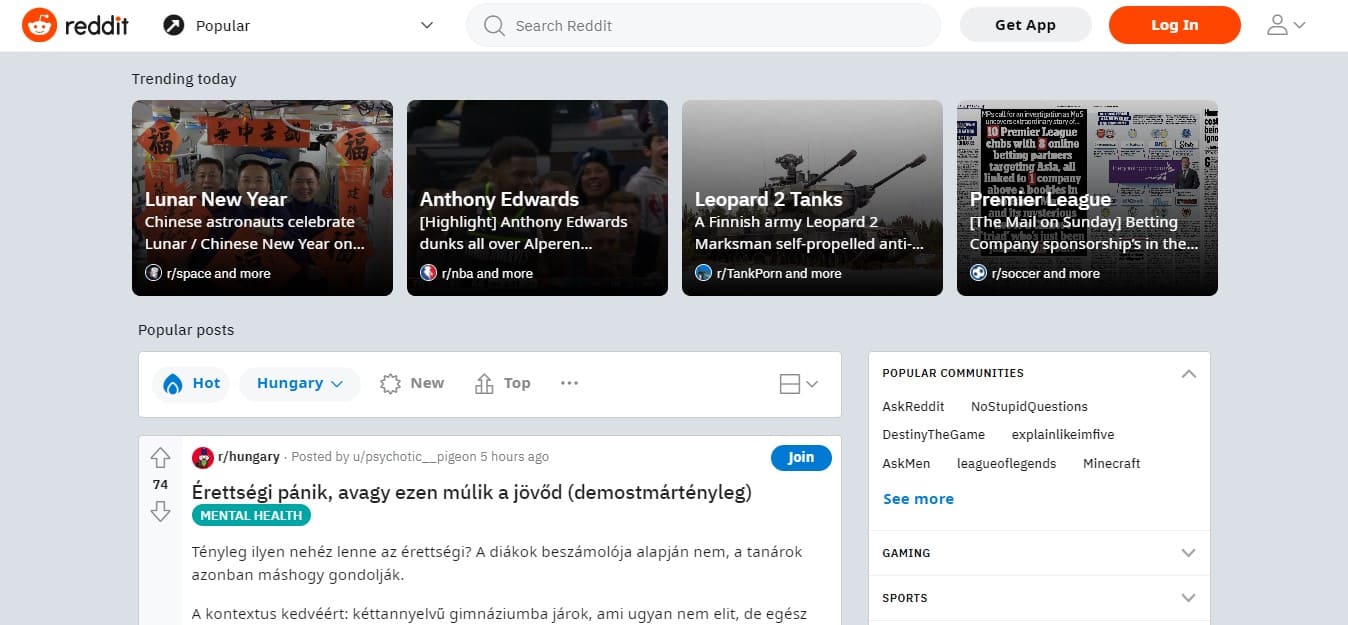
Reddit is a collection of forums hosted on a single domain name. Each individual forum is called a “subreddit,” and you can find one for virtually any topic out there. You can post your affiliate links, but some subreddits have clear rules against that and ban people who violate them. Ensure you post links only on subreddits that allow self-promotion, and even with that, don’t overdo it to avoid being marked as a spammer.
8. Quora
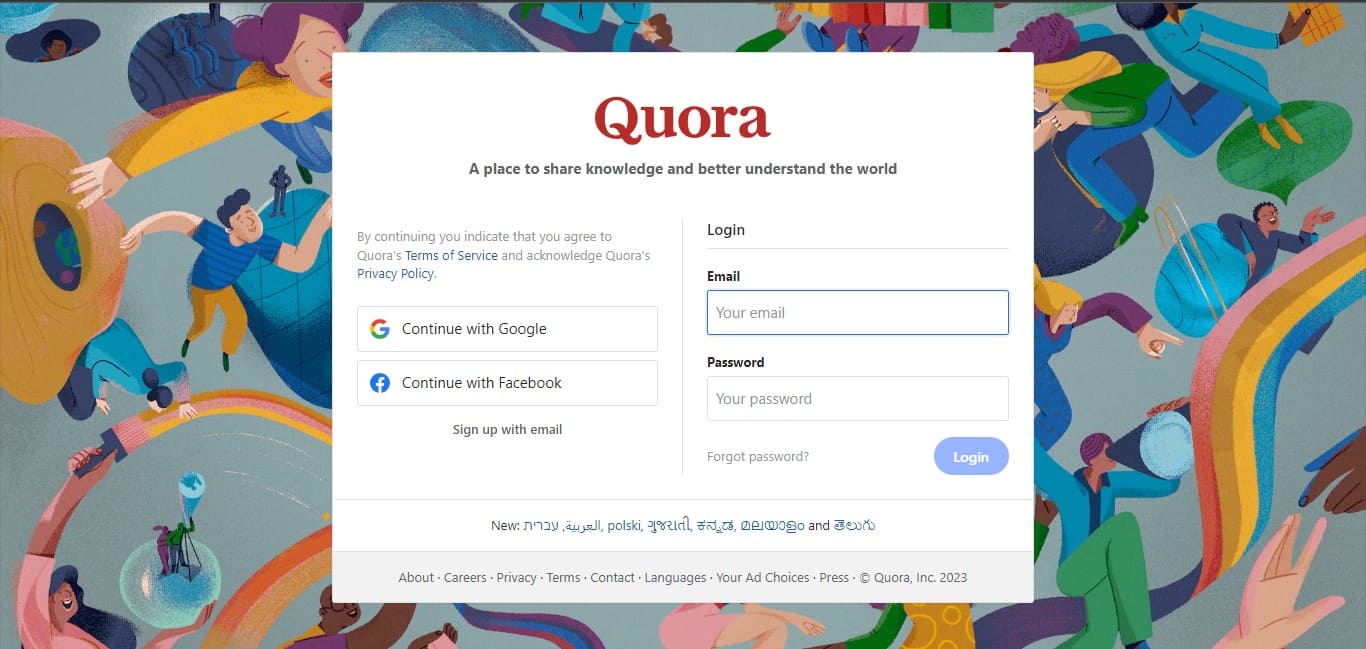
Quora is a questions-and-answers site where people ask for help about various topics and get answers from other users. You can answer questions related to your product category and slot in an affiliate link in them. Ensure that the link is relevant to the user’s question, which makes them more likely to click on it. Remember that the site’s purpose is to help users, not post random links, so play along.
9. YouTube
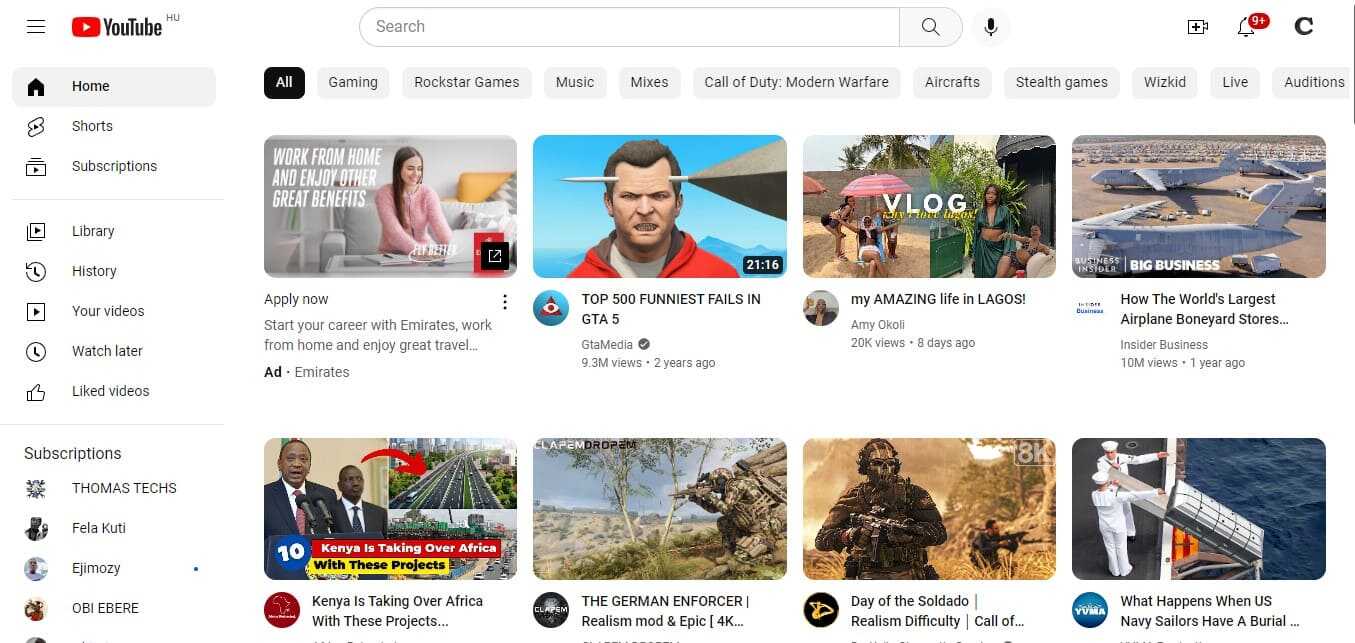
Almost everyone knows YouTube, the world’s most popular video-sharing site. Unlike many other platforms, YouTube’s algorithm won’t deprioritize your video if you post affiliate links in the description and promote affiliate offers. Thus, you can create engaging videos for your YouTube channel relevant to your affiliate product or service and include affiliate links to direct people to make a purchase. Add a call to action like “Link in the description” in the video to make viewers aware of your link.
10. Guest posting
Following best practices, guest posting lets you inject affiliate links into your high-quality content, promoting your affiliate offers from affiliate networks or even high ticket affiliate offers from brands. You can subtly showcase your expertise with a few tips drawn from your blog content, giving readers a reason to click through while getting direct traffic.
But guest posting isn’t only about the internal or external links. It’s also a great way to build genuine connections with bloggers and site owners in your affiliate marketing niche. These relationships can pay off in the form of referral traffic.
By planting your voice across niche-relevant platforms, you’re not just boosting SEO and getting more organic traffic, but leading specific audiences to your sales pages and building authority.
Guest posting isn’t a relic of content marketing and can be used as a source for affiliate marketing that you can employ to a loyal audience, promoting products.
Advanced traffic sources and strategies
Once you’ve mastered the fundamental approaches, like SEO and organic traffic, social media, and guest posting, it’s time to tap into more sophisticated traffic sources that offer scalability and long-term ROI and can also be a game changer. Here are several high-leverage strategies that go beyond the basics:
1. Ad network traffic source
Ad network traffic is one of the best sources because it offers instant, scalable access to millions of users across websites, apps, and platforms worldwide. With advanced targeting options, such as geo, device type, and browser, you can reach the right audience at the right time.
Plus, ad networks support a variety of ad formats (native advertising, display, or video ads), making it easy to match creatives to your funnel and optimize for more conversions.
Usually, they are honed to know how to deal with users’ ad fatigue and test and offer advanced high-converting formats. For example, with Adsterra, you can use the proprietary Social Bar ads that have up to 30% higher CTRs than any push ads.
2. Reddit and Quora ads
Both Reddit and Quora are way too popular. Still, they are incredibly powerful when used strategically. You can target users based on the exact topics they’re discussing or searching for. Ideal for niche products or services where you have a high-intent, specific audience.
3. Email drops via email campaigns
Partner with niche newsletter owners to acquire ad space in their email blasts. This puts your message in front of highly engaged, potential customers without the time investment of building your own list. These can drive direct clicks to your landing pages or affiliate program offers.
4. New SEO
Use AI tools, like SurferSEO, Frase, or alike, to generate optimized relevant content clusters that target long-tail keywords at scale. Combined with solid internal linking and trending topics, this approach can dramatically grow organic traffic with minimal manual effort.
5. Webinar funnels
Use webinars or live training as lead magnets for social media users. You can use YouTube traffic or traffic from other social platforms and build your funnel that converts incredibly well with the right messaging and urgency.
Future trends in affiliate traffic sources
Affiliate marketing efforts are getting more precise. More exciting new trends and affiliate marketing tools are on the way. They make it easier and more fun for brands and affiliate marketers to collaborate. Let’s take a quick look at what’s there:
- Bigger growth: Spending is passing US$12 billion, proving its value in driving sales. Performance-based models will stay the favorite.
- Smarter AI: AI enables brands to target audiences better, personalize ads, and automate marketing campaigns, saving time and money.
- Social media shopping: Shopping on social media accounts is getting easier with features like TikTok Shop and Instagram Checkout, allowing quick purchases directly from posts.
- Mobile traffic: With most affiliate traffic coming from phones, paid campaigns must look great and work well for mobile devices and mobile users.
- Fair rewards: Revenue-sharing is becoming one of the main payment methods, letting affiliates earn based on their performance.
- The metaverse: Brands are using virtual worlds to showcase products, offer digital goods, and create exciting shopping experiences.
Conclusion
With digital marketing, you don’t need to spend large sums of money to get noticed. You can get considerable affiliate traffic from the sources we listed, whether free or paid.
But it can take some time to find your perfect target audience and focus on it. We’ve mentioned the most important factors to consider if you want to choose the most suitable traffic source. Adsterra is an example of a high-quality traffic source. You can pay for ad impressions while driving user actions: clicks, orders, installs, and leads, and you get affiliate sales and commission payouts.
Affiliate traffic sources FAQs
Which is the best traffic source for affiliate marketing?
Search engine optimization and advertising are some of the most effective ways to generate traffic. Still, there’s no one-best-for-all traffic source in affiliate marketing. The beneficial variant depends on several factors, including your niche and target audience.
How to get traffic to affiliate links?
You can get traffic to affiliate links from numerous free and paid sources. Free sources include social media posts, search engine optimization to boost your own website rankings, posting on online forums, etc. Paid sources focus on buying different types of ads, such as In-Page Push and Social Bar, to drive traffic to your affiliate offers.
What are the different types of traffic sources?
The main types of traffic sources are paid and free. The paid ones include display advertising with a reputable network, including Banners, Pops, Social Bar, paid ad search, social media advertising, email marketing, etc. The free traffic sources are SEO traffic, online forums, and social media like Pinterest, Facebook groups, X (Twitter), Instagram, etc.
What is the best paid traffic source for affiliate marketing?
The best-paid traffic source for affiliate marketing is ad networks. It can provide a constant stream of traffic from multiple locations, a range of verticals, and top-converting ad formats for advertisers. Advanced ad networks also offer well-designed ad paid campaign optimization tools and targeted traffic, and audience settings.
![20 Best Traffic Sources for Affiliate Marketing in 2025 [For Top Conversions]](https://adsterra.com/blog/wp-content/uploads/2022/10/affiliate-traffic-sources-2025-1-780x364.png)
